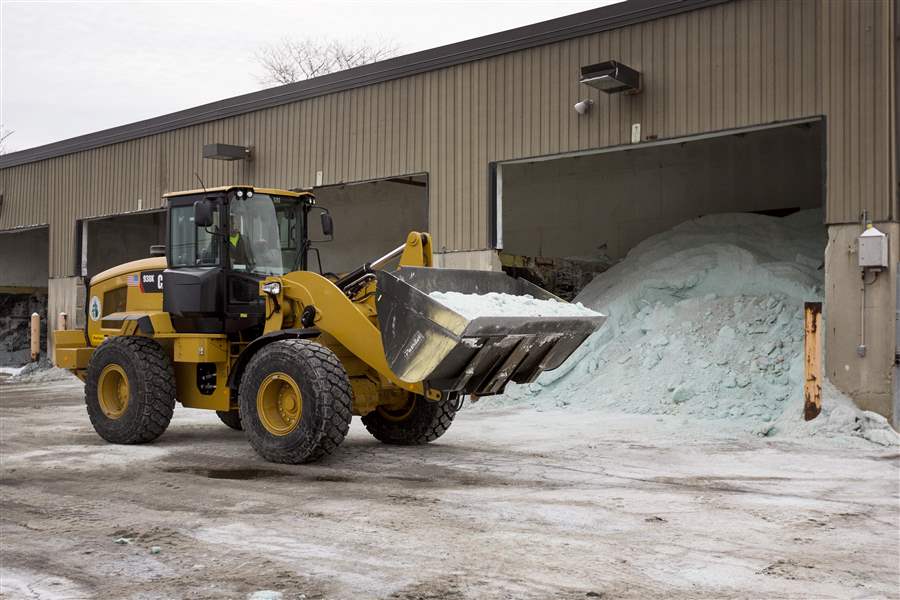
Long winter brings salt shortage, steeper prices
2/4/2014
Road salt is unloaded from storage at the public works facility in Glen Ellyn, Ill. The Midwest's recent severe winter weather has caused communities to expend large amounts of their road salt supplies.
ASSOCIATED PRESS

Road salt is unloaded from storage at the public works facility in Glen Ellyn, Ill. The Midwest's recent severe winter weather has caused communities to expend large amounts of their road salt supplies.
CHICAGO — As piles of snow grow taller during this seemingly endless winter, the mounds of salt for spreading on the nation’s icy, slushy roads are shrinking, forcing communities to ration supplies or try exotic new ice-melting substances.
Cities have already gone through most of their salt well ahead of the time they traditionally really need it — when the coldest part of winter gives way to temperatures just warm enough to turn snow into freezing rain and sleet and roads into ribbons of ice.
“If we don’t get the salt, at some point people are going to be sliding all over the place like what you saw in Atlanta,” said Julius Hansen, public works director in the Chicago suburb of Glen Ellyn, citing last week’s television images of thousands of motorists getting stranded on ice-covered roads in the South.
So far this year, Glen Ellyn’s snow-removal crews have responded to 31 storms.
“In an average winter, we have 20,” Hansen said.
A community the size of Glen Ellyn, population 27,000, might use 50 to 100 tons per storm. A bigger community such as Waukesha, Wis., which has about 70,000 residents, could use 300 tons or more. The same storm in Chicago would call for more than 13,000 tons.
Demand is so high that salt gets more expensive every day. Communities are trying to decide what do to. They could buy a little more salt now, when it costs twice or three times more than earlier in the season, and hope it doesn’t snow too much more. Or they could wait until it does snow more and risk paying even higher prices.
In some areas, there has been so much snow that cities have had to find creative ways to stretch their supplies: spreading salt only on intersections and major roads and mixing it with sand. In Indiana’s Morgan County, there is so little salt left that what is on hand will be mixed with sand and used only on the hills.
“We can only do what we can do,” county engineer Larry Smith said.
In Pennsylvania’s Butler County, they’re trying out a product called Beet Heet, made of processed sugar beet molasses, for anti-icing purposes.
Milwaukee road crews are experimenting with liquid cheese brine, mixing it in with rock salt before it goes on the road to make the salt wetter “so it will stick in place instead of bouncing away,” said Sandy Rusch Walton, a spokesman with Milwaukee’s Public Works Department.
Elsewhere, communities have cut back.
“As the season goes along, we become stingier,” said Fred Abadi, the public works director in Waukesha.
Motorists have noticed.
When Emira Palacios got into her car in Wichita, Kan., today, as another storm rolled in, “none of the streets had salt,” she said. “It is a little scary.”
Wichita has received only about 800 tons of the 3,000 tons of salt it ordered. So salt is being mixed with sand and road crews are given just enough of the mixture to cover emergency routes. When the salt runs out, road crews will use sand alone.
But sand has its limitations and can even create problems.
“Sand gives you some traction to get started, to stop, but it doesn’t do any melting,” said Joseph T. Pajor, deputy director of the city’s public works and utilities department.
Some communities have been told by suppliers that they must make do with the salt they have; no more is coming. Others have found salt for sale, but it must be transported by train from as far away as Utah or Canada.
Or they have been offered salt that is on barges, but that salt must be loaded onto trucks because the barges are stuck on frozen rivers and waterways.
“So the municipalities that could buy bulk salt early in the year at $53 a ton are now paying $130 a ton a week ago,” said Tom Breier, general manager of Ice Melt Chicago, which sells salt to cities and school districts. “And I heard the prices have gone up to $175 to $180 a ton. It could easily go to $200 a ton or more.”
By the end of January, the Pennsylvania Transportation Department had gone through 686,000 tons of salt — more than 200,000 tons beyond the amount used in a typical year.
The storms have driven up other costs, too.
Glen Ellyn spends about $50,000 in overtime in an average year. A mild winter can drive that as low as $15,000. But this year, “we are already at $80,000,” Hansen said.
Several communities simply weren’t ready for winter to be this cruel. They ordered salt based on a typical winter.
So far, Chicago has been socked with 30 inches more snow than the 21.6 inches it usually gets by this time of year. Milwaukee has received 14 inches more than the 29.2 inches it usually sees, according to the National Weather Service said.
“After two mild winters,” said Lori Roman, president of the Salt Institute, a trade group, “the severe weather has caught a lot of people off guard.”